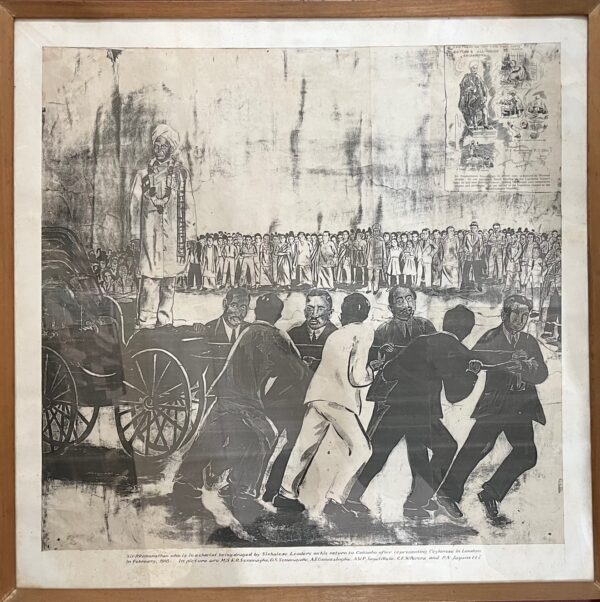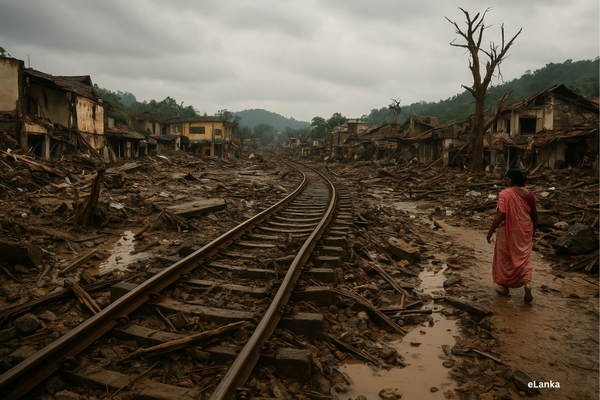Sir Ponnampalam Ramanathan’s Defiance: A Turning Point-by KKS PERERA
After successfully advocating for justice in London, Sir Ponnampalam Ramanathan returned to Ceylon to a hero’s welcome. His tireless efforts to expose the British administration’s oppressive measures, particularly the unjust imprisonment and mistreatment of national and temperance movement leaders after the 1915 riots, had earned him the admiration and gratitude of the people.
Recognizing his pivotal role in securing justice, Sinhala leaders and the public organized a grand reception to honor him. The most striking display of their appreciation was the symbolic act of leading him from the port in a grand procession, where prominent Sinhala leaders pulled the chariot carrying Ramanathan through the streets. This extraordinary gesture was a profound acknowledgment of his selfless service and the deep respect he had earned, transcending ethnic and political divides.
Thousands gathered to witness the event, with people lining the streets to cheer and pay tribute. His return became a moment of unity between the Sinhalese and Tamil communities, underscoring their collective struggle against colonial rule and injustice. It also demonstrated that, despite the British efforts to divide and control Ceylon through communal tensions, leaders like Ramanathan were capable of bridging ethnic differences in the pursuit of national justice. The grand welcome further ignited nationalist sentiments across the country, reinforcing the idea that Ceylonese of all backgrounds needed to stand together against British oppression. Ramanathan’s efforts, alongside the sacrifices of others like Henry Pedris, fueled the growing momentum for self-rule and laid the foundation for the independence movement that would gain strength in the coming decades.
A Ratnayake’s Account on Riots and Violence
Wasala Mudiyanselage Abeyratne Ratnayaka (1900 – 1977), a former minister who was just 14 years old at the time, bore witness to the horrifying communal violence that erupted in Ceylon. One fateful evening, as he stood near a Christmas carol cart, he saw tensions suddenly explode. A bottle was hurled from the crowd, shattering on impact, and in the next moment, chaos erupted as a group of people near a mosque launched an attack. The violence quickly escalated into retaliation, with enraged mobs turning their fury toward the mosque. The structure was soon destroyed, and what followed was even more devastating—Muslim-owned businesses, homes, and properties were set ablaze, casting a fiery glow over the night sky. What had started as an isolated confrontation spiraled into widespread communal riots, leaving destruction in its wake and deepening ethnic divisions that would have lasting repercussions.
Uprisings in 1818 & 1848
Even before the communal tensions of the early 20th century, Ceylonese resistance to British colonial rule had a long and bloody history. In 1818, a significant rebellion erupted in Uva-Wellassa, led by local chieftains determined to expel the British and reclaim sovereignty. However, the British, armed with superior weaponry and a brutal approach to rebellion, swiftly crushed the uprising. Thousands were slaughtered, villages were razed, and entire communities were left in ruins.
Thirty years later, in 1848, a larger and more widespread rebellion broke out, sending shockwaves through the British administration. Fueled by rising taxation, economic hardships, and resentment toward colonial rule, the revolt spread rapidly across the island, from Kandy to Matale and even parts of Colombo. Alarmed by the scale of the uprising, the British feared losing control of the colony. In response, the colonial administration unleashed extreme suppression, particularly in Uva, Sabaragamuwa, Central, and North Western Provinces. Mass executions, public hangings, and military crackdowns followed, resulting in immense loss of life. Though the rebellions were ultimately crushed, they planted the seeds of nationalism and fueled growing anti-colonial sentiment. The Buddhist revival that followed, particularly after the Panadura Debate of the 1870s, became a crucial turning point in Ceylon’s struggle for independence.
Escalation of Riots-1915
The British colonial administration played a central role in escalating tensions between communities through policies of control and segregation. One particularly volatile issue arose when British authorities restricted the Kandy Esala Perahera from passing near the Castle Hill Street Mosque. This decision, seen as an insult to Buddhist traditions, ignited outrage among the Sinhalese population, further deepening religious and ethnic divides. Rumors quickly spread, with false reports alleging that Muslims had attacked the Temple of the Tooth. These fabricated claims fueled communal paranoia, creating an atmosphere of fear and hostility. The situation soon spiraled out of control as riots broke out, driven by misinformation and growing distrust between communities.
The British administration’s response was both delayed and inadequate. Instead of taking preventive measures, colonial officials allowed the violence to escalate before belatedly declaring Martial Law. By the time military intervention was ordered, widespread destruction and loss of life had already occurred, intensifying resentment toward British rule and strengthening calls for self-governance.
Cold-blooded Execution of Henry Pedris
Among the most tragic and politically significant figures of this era was Edward Henry Pedris (1888–1915), a young and respected officer in the Colombo Town Guard. When riots broke out in 1915, Pedris was assigned to control unruly mobs and protect Muslim-owned businesses. Despite his efforts to de-escalate tensions, he was falsely accused by the British authorities of inciting violence against the Muslim community. In a mockery of justice, Pedris was hastily court-martialed and sentenced to death. The British sought to make an example of him, aiming to crush nationalist sentiments and instill fear among the local population. His execution was carried out in cold blood, and to further intimidate the people, the colonial government took his blood-soaked chair into prison, where prominent temperance leaders, like the Senanayake brothers, were unjustly held— a chilling warning of the fate that awaited those who dared to oppose British rule.
However, far from suppressing dissent, Pedris’ martyrdom became a rallying cry for the independence movement. His name became synonymous with sacrifice, resistance, and patriotic fervor, galvanizing nationalists across the island.
Sir Ponnampalam Ramanathan’s Advocacy
As British oppression reached its peak following the riots, Ponnampalam Ramanathan emerged as one of the most influential voices in the fight for justice. Although a Tamil leader, Ramanathan stood in solidarity with the Sinhalese, condemning British brutality and authoritarianism. He took it upon himself to gather affidavits and firsthand accounts from those who had suffered under colonial repression, compiling undeniable evidence of the British administration’s atrocities.
Determined to seek justice, Ramanathan traveled to England, where he met personally with British officials and lawmakers, including key figures in the colonial government. Fearlessly, he exposed the misdeeds of Governor Chalmers, detailing the excessive force, wrongful detentions, and suppression of the Sinhalese people under Martial Law. His unwavering commitment to the cause pressured the British government to act, ultimately leading to the repeal of Martial Law and the recall of Governor Chalmers.
Impact on the Independence Struggle
By 1917, nationalist groups such as the Young Lanka Youth League and the Ceylon National Congress began to emerge, advocating for greater self-rule and political reforms. Key figures like D.S. Senanayake, F.R. Senanayake, and other nationalist leaders pushed for constitutional changes, laying the groundwork for Ceylon’s path to independence. Pedris and Ramanathan stood as powerful symbols of the resilience and unity of the Ceylonese people in the face of colonial oppression. Their contributions remain a significant chapter in Sri Lanka’s history, shaping the nation’s journey toward freedom.
“Sir Ponnambalam Ramanathan – Foster Parent of the Sinhalese” was the title of a speech delivered by J.R. Jayewardene at the Swami Vivekananda Centre on November 30, 1991. Speaking further, he stated, “By his contribution to national life, he helped revive the spirit of the Sinhala people, particularly in their religion, language, and self-governance. In fact, the first Prime Minister, Rt. Hon. D.S. Senanayake, once echoed this sentiment, describing him as “one of the greatest Ceylonese of all time.”
[Extract from the full speech, preserved in a booklet at the JRJ Centre Library]
kksperera1@gmail.com

Image: An artist’s impression of Sir Ponnambalam Ramanathan being drawn in a chariot by Sinhala leaders, including D.S. Senanayake, F.R. Senanayake, A.E. Gunasinghe, E.W. Perera, and others, upon his return to Ceylon from London, after representing the Ceylonese. –Courtesy: JRJ Centre Library.





















